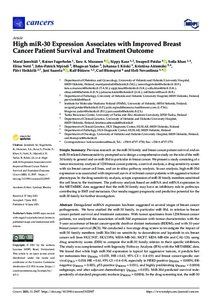High miR-30 Expression Associates with Improved Breast Cancer Patient Survival and Treatment Outcome
Kaur Sippy; Aittomäki Kristiina; Saarela Jani; Bützow Ralf; Muranen Taru A.; Heikkilä Päivi; Kiiski Johanna I.; Fagerholm Rainer; Jamshidi Maral; Khan Sofia; Yadav Bhagwan; Netti Eliisa; Nevanlinna Heli; Blomqvist Carl; Mpindi John-Patrick; Potdar Swapnil
High miR-30 Expression Associates with Improved Breast Cancer Patient Survival and Treatment Outcome
Kaur Sippy
Aittomäki Kristiina
Saarela Jani
Bützow Ralf
Muranen Taru A.
Heikkilä Päivi
Kiiski Johanna I.
Fagerholm Rainer
Jamshidi Maral
Khan Sofia
Yadav Bhagwan
Netti Eliisa
Nevanlinna Heli
Blomqvist Carl
Mpindi John-Patrick
Potdar Swapnil
MDPI
Julkaisun pysyvä osoite on:
https://urn.fi/URN:NBN:fi-fe2021093048454
https://urn.fi/URN:NBN:fi-fe2021093048454
Tiivistelmä
Simple Summary Previous research on the miR-30 family and breast cancer patient survival and on miR-30-related chemosensitivity prompted us to design a comprehensive study on the role of the miR-30 family in general and on miR-30d in particular in breast cancer. We present a study consisting of a tumor microarray analysis of 1238 breast cancer patients, a survival analysis, a drug-sensitivity screen with six breast cancer cell lines, and an in-silico pathway analysis. In our analysis, high miR-30d expression was associated with improved survival in breast cancer patients with aggressive tumor phenotypes. In the drug-sensitivity analysis, ectopic expression of miR-30 family members sensitized the cell lines to the treatment. The pathway analysis based on miRNA and mRNA expression in the METABRIC data suggested that the miR-30 family may have an inhibitory role in pathways contributing to EMT and metastasis. Our results suggest prognostic and predictive potential for the miR-30 family for further investigation. Deregulated miRNA expression has been suggested in several stages of breast cancer pathogenesis. We have studied the miR-30 family, in particular miR-30d, in relation to breast cancer patient survival and treatment outcomes. With tumor specimens from 1238 breast cancer patients, we analyzed the association of miR-30d expression with tumor characteristics with the 5-year occurrence of breast cancer-specific death or distant metastasis (BDDM), and with 10-year breast cancer survival (BCS). We conducted a two-stage drug-screen to investigate the impact of miR-30 family members (miR-30a-30e) on sensitivity to doxorubicin and lapatinib in six breast cancer cell lines HCC1937, HCC1954, MDA-MB-361, MCF7, MDA-MB-436 and CAL-120, using drug sensitivity scores (DSS) to compare the miR-30 family mimics to their specific inhibitors. The study was complemented with Ingenuity Pathway Analysis (IPA) with the METABRIC data. We found that while high miR-30d expression is typical for aggressive tumors, it predicts better metastasis-free (p(BDDM) = 0.035, HR = 0.63, 95% CI = 0.4-0.9) and breast cancer-specific survival (p(BCS) = 0.018, HR = 0.61, 95% CI = 0.4-0.9), especially in HER2-positive (p(BDDM) = 0.0009), ER-negative (p(BDDM) = 0.003), p53-positive (p(BDDM) = 0.011), and highly proliferating (p(BDDM) = 0.0004) subgroups, and after adjuvant chemotherapy (p(BDDM) = 0.035). MiR-30d predicted survival independently of standard prognostic markers (p(BDDM) = 0.0004). In the drug-screening test, the miR-30 family sensitized the HER2-positive HCC1954 cell line to lapatinib (p < 10(-2)) and HCC1937, MDA-MB-361, MDA-MB-436 and CAL120 to doxorubicin (p < 10(-4)) with an opposite impact on MCF7. According to the pathway analysis, the miR-30 family has a suppressive effect on cell motility and metastasis in breast cancer. Our results suggest prognostic and predictive potential for the miR-30 family, which warrants further investigation.
Kokoelmat
- Rinnakkaistallenteet [19207]
